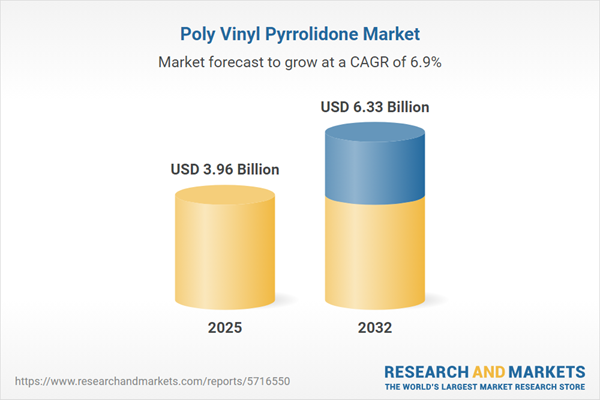Speak directly to the analyst to clarify any post sales queries you may have.
The polyvinyl pyrrolidone market is increasingly central to executive agendas, as organizations across regulated sectors require effective strategies to navigate compliance demand, build resilient supply frameworks, and refine procurement. Senior leaders are focusing on specialty polymer solutions to elevate operational efficiency and risk mitigation amid shifting global market pressures.
Market Snapshot: Polyvinyl Pyrrolidone Market Outlook
In 2024, the global polyvinyl pyrrolidone market is valued at USD 3.71 billion, projected to reach USD 3.96 billion by 2025, with a compound annual growth rate of 6.91%. Growth is robust due to widespread adoption in chemicals, pharmaceuticals, personal care products, and water treatment. As business operations grow more complex, innovation within the polyvinyl pyrrolidone market is reshaping product management and adaptability to new compliance demands. Senior executives are utilizing the polymer’s flexibility to streamline procurement workflows, design targeted regional supply strategies, and align operations to ongoing regulatory and industry shifts.
Scope & Segmentation of the Polyvinyl Pyrrolidone Market
Targeting executive information needs in procurement and supply chain management, this analysis clarifies the primary drivers, core segmentation, and risk-mitigation approaches shaping the specialty polymer market for polyvinyl pyrrolidone.
- Application Areas: Used to ensure compliance and efficiency across adhesives, construction, engineered wood, pressure-sensitive products, oral and personal care, pharmaceutical excipients, and water treatment. Each area faces unique technical and regulatory demands, positioning polyvinyl pyrrolidone as an integral ingredient supporting product stability and market trust.
- Molecular Weight Categories: Available in K12, K17, K30, and K90, each grade delivers tailored binding or thickening properties, meeting the precise requirements of pharmaceuticals, specialty chemical manufacturing, and advanced polymer processes.
- Grade: Developed to fit sector-specific standards in cosmetic, food, pharmaceutical, and technical applications. Adhering to stringent quality benchmarks reinforces confidence among stakeholders and customers in highly regulated environments.
- Distribution Channels: Comprises direct buying, regional or national distributor partnerships, and digital B2B procurement networks, each offering flexible supply continuity and risk management for strategic buyers.
- Geographic Coverage: The Americas, Europe, Middle East & Africa, and Asia-Pacific regions each exhibit distinct regulatory standards and consumer requirements, making regional adaptation key to maintaining compliance and continuous supply.
- Company Coverage: Market presence is shaped by major participants such as Ashland LLC, BASF SE, Wacker Chemie AG, Merck KGaA, and Kemira Oyj, serving as benchmarks for supplier evaluation and procurement strategy optimization across sectors.
Key Takeaways for Senior Leaders
- Adopting green chemistry principles and sourcing bio-based raw materials help drive responsible specialty polymer production, strengthening sustainability credentials and market acceptance.
- Increasing regulatory scrutiny requires organizations to enhance traceability and transparency, especially within food and personal care supply chains, supporting proactive risk management.
- Digital transformation, including procurement automation, improves real-time decision-making, allowing rapid response to regulatory and market changes while reducing operational complexity.
- Polyvinyl pyrrolidone’s multi-faceted functionality reinforces supply security, enabling operational continuity even amid uncertain market or compliance environments.
- Diversifying sourcing strategies and expanding supplier networks are proven approaches for reducing risk related to geopolitical instability or disruptions in global and regional supply chains.
Tariff Impact: US Tariffs on PVP Supply Chains
Forthcoming US tariffs on imported polyvinyl pyrrolidone will prompt review and adjustment of sourcing models for 2025. Executives will benefit from evaluating alternative procurement strategies, deepening supplier engagement, and striking a balance between domestic and international purchases. Ongoing monitoring of trade policy changes is essential to sustaining performance and mitigating supply risks under new tariff regimes.
Polyvinyl Pyrrolidone Market Methodology & Data Sources
Research is grounded in executive interviews, in-depth industry publications, and scenario-based quantitative modeling. Findings are rigorously validated to ensure they offer actionable, evidence-based guidance for procurement and supply chain decisions by senior stakeholders.
Why This Report Matters
- Enables data-driven procurement and investment planning specific to the polyvinyl pyrrolidone sector.
- Clarifies regulatory and digital factors impacting supply chain efficiency and diversified supplier portfolios.
- Delivers credible supplier benchmarks, supporting robust strategies for specialty polymer procurement and risk reduction.
Conclusion
This report equips decision-makers to enhance compliant procurement, develop resilient sourcing strategies, and secure competitive positioning within the specialty chemicals value chain.
Additional Product Information:
- Purchase of this report includes 1 year online access with quarterly updates.
- This report can be updated on request. Please contact our Customer Experience team using the Ask a Question widget on our website.
Table of Contents
3. Executive Summary
4. Market Overview
7. Cumulative Impact of Artificial Intelligence 2025
Companies Mentioned
The companies profiled in this Poly Vinyl Pyrrolidone market report include:- Ashland LLC
- BASF SE
- Wacker Chemie AG
- Merck KGaA
- Kemira Oyj
- Anhui Wanwei Group Co., Ltd
- Weifang Huafeng Chemical Co., Ltd
- Sichuan Haizhuo Chemical Group Co., Ltd
- Changzhou Longjun New Materials Co., Ltd
- Shin-Etsu Chemical Co., Ltd
Table Information
| Report Attribute | Details |
|---|---|
| No. of Pages | 184 |
| Published | November 2025 |
| Forecast Period | 2025 - 2032 |
| Estimated Market Value ( USD | $ 3.96 Billion |
| Forecasted Market Value ( USD | $ 6.33 Billion |
| Compound Annual Growth Rate | 6.9% |
| Regions Covered | Global |
| No. of Companies Mentioned | 11 |









